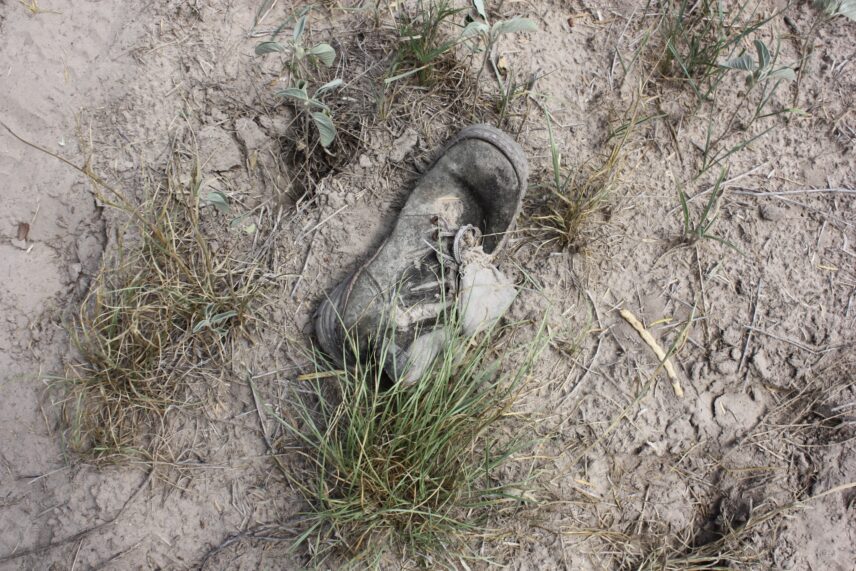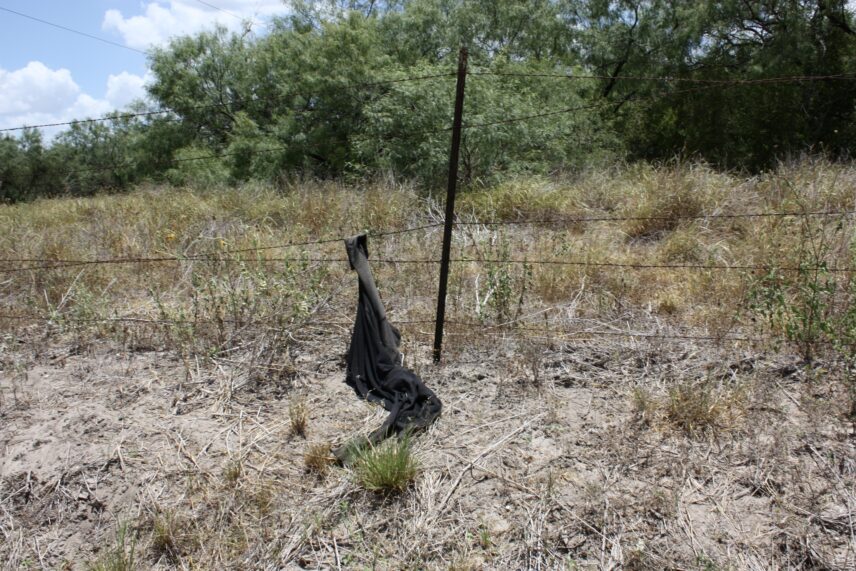Article begins
On Halloween we see our neighbors lay out anatomical skeletons on their grassy front lawns. Heavy books thick with high-quality war images line bookstore shelves and decorate coffee tables. Popular crime-solving shows are increasingly vivid in their depiction of gore. It can be argued that imagery of bodily human remains proliferate in everyday life. Yet, when asked about my work along the United States-Mexico border, people are often surprised when I say that I study the recovery of the deceased, confused when I say I don’t think that showing images of the dead is a binary issue. How do anthropologists navigate the decision-making of including images of the dead in our work? Under what circumstances is it permissible to publish such images, if ever? And in the case of clandestine migrants, how can we honor and show respect for those who perish?
In the early summer of 2022, I packed the trunk of my Prius and drove five hours south to a small town in South Texas. I had traveled there to conduct my pilot research, driven by personal and humanitarian interests in the law enforcement process of recovering the bodies of clandestine migrants who died during their journey north from the United States-Mexico border. Some anthropologists would argue that these individuals were killed by immigration policies intended to funnel migrants into the most dangerous terrain along the United States-Mexico border. Law enforcement officers I met in the field often blamed the human smugglers or coyotes who reportedly abandoned migrants in the desert without photo identification, cell phones, or clean water. The hundreds of police reports I read indicated exposure to elements and hyperthermia as causes of death. These people died in crisis. Their deaths are tragic.

Studying the recovery of migrant remains presents unique challenges. The work itself is emotionally fraught, requiring a consistent interrogation of personal positionality and privilege as a citizen researcher. Linguistically, the implication of remains versus bodies versus cadavers carries weight and varying levels of attachment. In this piece I use remains to refer to bodies and body fragments of the deceased, both in accordance with forensic recovery team interlocutor terminology and the implication that what is recovered is only part of what was once whole.
Physically, remain recoveries often require traversing hostile terrain for hours, patiently inspecting the desert. Environmental systems can be difficult to predict, and animal scavenging and weather patterns not only influence the decomposition rate of bodies but are key factors in whether such remains are ever recoverable. Cultural factors including the timeliness of the remains being reported and artifacts that accompany them also influence the process of identification and potential repatriation. I remember sharing feelings of frustration with interlocutors in the field after long days of failed searches, a quiet desperation in going just a little longer, knowing how many migrants perish along the border and how few are found. In an environment where bodily remains are threatened with complete deterioration in a matter of years, the role of photography at sites of recovery becomes an important tool for researchers.
Photographs taken during remain recovery missions play an important role in the identification process and further the knowledge of what happens to migrant bodies after death along the border. Photographs at the scene of recovery also provide documentation of details recovery teams might overlook in the field. I saw many of these photos kept in law enforcement offices, organized in plastic binders and sorted by date. Officers would pull the binders off the shelf when relatives called or arrived in person to inquire about a missing loved one. The images would be poured over with location, artifacts, timeline, and other factors taken into consideration. A relative’s shaky fingers would trace outlines on photos of familiar sweatshirts, a unique rosary. Sometimes enough details would align for steps to be taken to provide a positive identification, sometimes this process was less successful. Without photographic evidence, these potential identifications would be impossible. The images are critical to the process of law enforcement identification of the remains, but where do images of migrant remains fit into anthropology?
As anthropologists we are consistently confronted with ethical choices. We find ourselves seeking to avoid the traumatic replication of our discipline’s colonial past, while actively positioning ourselves as observers and cultural analysts. Scholars who grapple with the tragedy of clandestine migrant deaths along the United States-Mexico border are often at odds with the gratuitous publication of images in newspapers, news programs, and magazine materials, intended to shock and awe audiences, perpetuating an already prolific harm. But there is a realness to the shock of the firsthand experience of encountering migrant remains. There is a gut punch, a fluttering of panic; laying alone in a desert ranchland are human remains with belongings scattered haphazardly around them, photographs of family members caught on desert shrubbery, pages of a pocket-sized Bible half covered in sand. How does one make the reality of this tragedy tangible to those who are not there? When applied thoughtfully, the answer can be photography.

The first time I encountered migrant remains came unexpectedly. I received a call from an interlocutor; they had a 500, he told me, local law enforcement code for a dead body. He knew I was interested in the process of recovering remains, what happens once they’re collected, and where they go. You’re welcome to come along, he told me. We drove through the ranch property where the body had been discovered, the tires of the Jeep sputtering and spinning in the deep sand until we lurched to a stop behind a Border Patrol truck. Clambering out of the car and following the lead of the officers at the scene, I began circling the site. We hunched, scrutinizing the desert sand for evidence of who this person had been. Our group circled inward until our spirals led us to the remains.
There is a certain melancholia I feel toward the desert in South Texas, the harsh beauty of the sharp shrubbery, the warmth of the heavy air; this contrast of the setting sun, a light breeze, and a body ravaged by the elements. At first, it was difficult to look at him. I thought he wouldn’t have wanted me, a young, out-of-place woman, looking at him like this; I thought he might not have cared; I thought, I’ll never know. Looking up toward the thin branches above us, I took a photo of the sky. At that moment I thought that this was evidence of the last horizon this man might have seen in life. After learning how his body had been scavenged and likely dragged to this site by wild boars, I realized it was only an image of the sunset. But it was the image of a setting sun above the body of a man who had migrated from far away, a man with a silver wedding ring on his curled left hand.
As an anthropologist and empathetic researcher, I recognize the power of bringing the reality of the crisis along the United States-Mexico border to those who have not seen it. I believe this reality should be shown as thoughtfully and as realistically as possible, and I consider photography a crucial tool in this process. For me to consider publishing a photo of bodily remains would require the remains to have been identified, relatives contacted, and consent received. The closest I can get to the consent of the individual is consent from their kin. I now see the risk of publishing consented images of migrant remains to an audience who can interpret and utilize the images as they want as less than the risk of minimizing or sidestepping the tragedy of these deaths. Applying a blanket conclusion of yes or no in the consideration of including images of migrant remains in anthropological work would be a disservice to the nuanced experiences of migrants who cross the United States-Mexico border, and the wishes of the loved ones of those who perish. Each case demands the respect of individual consideration, just as each unique set of remains belonged to an individual with a life, a goal, and someone, somewhere, left behind.
We know that images of the dead are not difficult to encounter. Newsreels, photojournalism, and documentary films are just some spaces where images of human remains are published and circulated with and without the consent of kin. The remains of migrants who perish along the United States-Mexico border are no exception to these circulations. Anthropologists who work at the United States-Mexico border have difficult ethical decisions to make when it comes to the inclusion of images in their published works. Where is the line between gratuitous imagery and realistic representation of death at the border? What can be learned from images of migrant remains, and what of the marginalized migration experience might be centered through their circulation? Questions like these should be front of mind for anthropologists working with migrant remains. Every decision from the choice to begin capturing photos, to the words one uses when asking survivors for consent, should be thoughtfully weighed and intentionally acted on. Imagery of migrant remains can have an impactful place in anthropology, but only when ethical decision-making is foregrounded, consent received, and individual factors respected.
Related works and topical discussion
Colwell, Chip. 2020. “Is It Ever Okay to Publish Photographs of Human Remains.” SAPIENS, March 11.
Cuelenaere, Laurence. 2023. “On the Migrant Image and the Violence of Photography.” American Anthropologist website, May 18.
Latham, K. E., A. J. O’Daniel, and T. Ramos. 2023. “Migrant Death and the Ethics of Visual Documentation in Forensic Anthropology. In Anthropology of Violent Death, edited by R. C. Parra and D. H. Ubelaker. Hoboken, NJ: Wiley.

